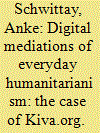| Srl | Item |
| 1 |
ID:
168481


|
|
|
|
|
| Summary/Abstract |
The proliferation of Web 2.0 platforms that aim to facilitate social action, often connected to international development or environmental sustainability, has contributed to the ongoing popularisation of development. In this article, I argue that it has resulted in the digitally-enabled constitution of everyday humanitarians, who are everyday people supportive of poverty alleviation. Kiva.org, a US-based online microlending platform that invites everyday humanitarians to make US$25 loans to Kiva entrepreneurs around the world, is a prime site to study these processes. I show how Kiva cultivates supporters through the mediated production of affective investments, which are financial, social and emotional commitments to distant others. This happens through the design of an affective architecture which in turn generates financial and spatial mediations. While these result in microloans and attendant sentiments of affinity, they also lead to financial clicktivism and connections that obscures the asymmetries and riskscapes resulting from Kiva’s microlending work.
|
|
|
|
|
|
|
|
|
|
|
|
|
|
|
|
| 2 |
ID:
171882


|
|
|
|
|
| Summary/Abstract |
his paper uses Renrendai data to study the relationship between monetary policy and the default behavior of borrowers, and analyzes the transmission channels. The research shows that tight monetary policy will lead to a significant increase in a borrower’s probability to default, and this effect will continue for several months. There may be two transmission channels: (i) monetary policy changes a debtor’s liquidity through credit and balance sheet channels, which directly affects their current repayment behavior; and (ii) monetary policy may affect a borrower’s investment, production and protability, thus changing their long-term solvency. The paper also nds that the repayment behavior of productive borrowers is more susceptible to monetary policy than consumptive borrowers, and that the default behavior of borrowers in coastal provinces is more susceptible to monetary policy than of borrowers in inland provinces. These ndings provide new evidence for understanding how monetary policy affects individual behavior and its transmission mechanisms.
|
|
|
|
|
|
|
|
|
|
|
|
|
|
|
|